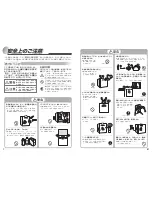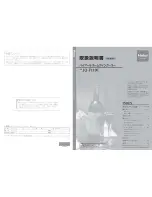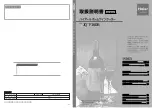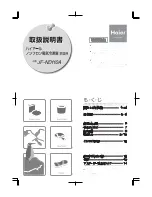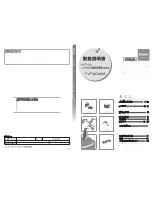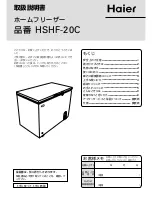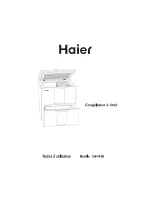
8
o
If you are freezing liquid, then do not fill the container to the brim.
Liquids will expand when being frozen.
o
For frozen food, refer to the storage time written on the food
packaging. This storage time is achieved whenever the setting
respects the reference temperatures of the compartment (one-star
-6°C, two stars -12°C, three stars -18°
Do not place bottles (glass or tin) containing liquids (especially
sparkling liquids) into the freezer as they could cause the bottle to
burst during freezing.
Making ice cubes
o
Fill the ice cube tray with water and place it in the freezer
compartment.
o
After the water is completely frozen and turned to ice, you can twist
the ice cube tray (as shown in the drawing below) to dispense the
ice.
SAVING ENERGY WHEN USING YOUR FREEZER
Installing:
o
Install the appliance in a cool position. If it is placed in direct
sunlight or next to an oven or other heat source, the energy
consumption can increase substantially.
o
Ensure the appliance is installed with the correct ventilation
requirements. Restricting ventilation can increase the energy
consumption by 15%.
Cleaning and Maintenance:
o
Occasionally clean the condenser coils (if present) at the back of
the appliance to maintain a high performance level.
o
Defrost the appliance regularly. A build up of thick ice decreases
the efficiency of the appliance. You should defrost whenever the
frost reaches 5 mm thickness.
o
Clean the door gasket with warm water or a neutral detergent
that leaves no residue. A tight-sealing door gasket is critical to the
efficiency of your appliance.
Usage:
o
Do not open the door repeatedly or more frequently than you
have to.
o
Do not set the thermostat too low. A change of just one degree
can effect the energy consumption by 5%. Use a thermometer to
check the temperature.
o
The freezer should operate at -15 to -18 degrees Celsius.
o
Allow food to sufficiently cool before putting it in the appliance
(but don’t let it sit at room temperature for too long).
o
In the freezer, food packages should be scattered and never
grouped or stacked together until they are completely frozen.
o
If you are going away for a long period of time, turn off the
appliance, empty and clean it and leave the door ajar.
o
If you have a second appliance that is not used, make sure that it
is stored with the power off and the door left ajar until it is
actually required.
o
Disposing:
o
If you're going to throw out your old fridge, see if there's a
chlorofluorocarbons (CFCs) recycler in your area. The government
department which looks after the environment in your area may be
able to help you.
CLEANING AND MAINTENANCE
WARNING: PLEASE ENSURE THAT YOUR APPLIANCE IS DISCONNECTED FROM
YOUR MAINS SUPPLY BEFORE ATTEMPTING TO CLEAN IT.
o
Do not clean the appliance by pouring water onto it or spraying water over it.
o
The freezer should be cleaned periodically, using a solution of bicarbonate of
soda and lukewarm water.
o
Clean the accessories separately with soap and water. Do not clean them in a
dishwasher.
o
Do not use abrasive products, detergents or soaps.
o
After washing the appliance, wipe over the area that you have cleaned with a
damp cloth and then dry it thoroughly.
o
When cleaning is complete, dry your hands and then reconnect the plug to
your mains supply.
Defrosting the freezer compartment
The frost in the freezer compartment should be removed periodically. You can
use a plastic scraper to keep down the amount of frost that builds.
IMPORTANT: The freezer should be defrosted at least twice a year. The
number of times that you need to defrost it, will depend on the setting of
your thermostat and how much food you freeze and store in the freezer.
o
The day before you defrost, turn the thermostat dial to position <5>, this
will make sure that the food contained in the freezer is frozen properly.
o
Whilst defrosting the appliance, the food should be removed from the
freezer and wrapped in several layers of paper and stored in a cool place.
The foods rise in temperature will shorten its storage life and therefore the
food should be used within a relatively short period of time.
DO NOT PLACE FOOD BACK IN THE FREEZER ONCE IT HAS STARTED TO THAW.
o
Set the thermostat knob to position <0> and disconnect the appliance from
your mains supply.
o
Leave the door to the freezer open. You can place a bowl of warm water
inside the freezer to speed up the defrost process.
o
You can use a sponge to mop up the defrost water that will run into the
bottom of the freezer.
IMPORTANT: You should place some old towels on the flooring that is
immediately in front of the appliance. In case any defrost water comes out of
the freezer and onto the floor.
o
Once all the ice that has built up has melted, then the inside of the freezer
should be dried thoroughly. Failure to do this will result in immediate ice
build when the appliance is switched back on.
o
With dry hands, reconnect your appliance to your mains supply. Set the
thermostat knob to position <5> for a 24 hour period, before returning it to
the normal setting of <3>.
o
You should not attempt to freeze fresh food inside the freezer until this 24
hour time period has elapsed.
Do not defrost the appliance with other electrical devices (e.g. hair dryer). Do
not use sharp metal objects to remove the ice on the freezer, as this could
cause damage to the refrigerant system.
INSTALLATION
IMPORTANT: Before installation and usage read all the instructions and make
sure that the voltage (V) and the frequency (Hz) indicated on the rating plate
are exactly the same as the voltage and frequency in your home. The rating
plate can be found on the front left edge of the
inside of the refrigerator.
Summary of Contents for HBFUP 130 NK/N
Page 1: ...1 USER MANUAL FREEZER...
Page 73: ...74 bed breakfasts B B 4 220 240 VAC 50 Hz 3 3...
Page 74: ...75...
Page 75: ...76 8 3 8 R600a...
Page 76: ...77 48 5...
Page 77: ...78 4 2012 19 EU WEEE WEEE WEEE WEEE WEEE WEEE WEEE 2 3 1 1 3 2 5 1 6...
Page 78: ...79 o o o o o o 24 o 24 o o o 5 6 3 3 1 5 SF SF 24 1 2 25 35 C 3 4 15 25 C 5 5 15 C 18 4 5 24...
Page 79: ...80 6 C 12 C 18 C o o 15 o o 5 mm o o o 5 o 15 18 o o o o o CFC o o o o o o 5 0...
Page 81: ...82 o 1 o o 3 o 1 o 2 o 1 2 o 3 o o m 90 mm n 140 mm 1 2 o...
























